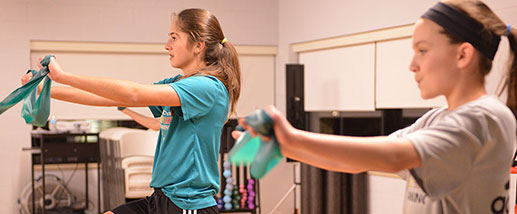Knees 101: What You Need to Know About Injury, Surgery & Recovery
June 12, 2025
By: Darin Estep
Categories: Orthopedics (Bones, Joints, Muscles)
Tags: Knee, Knee Replacement, Joint Pain, Joint Replacement
Timothy Henne, MD, is a fellowship-trained orthopaedic surgeon with Trinity Health Medical Group. Dr. Henne specializes in repair, reconstruction and replacement of the knee — the largest joint in the body and one of the most easily injured.
Dr. Henne uses his extensive background in sports medicine — including helping NFL and college players return to the game — to help athletes of all ages and people who simply want to return to the activities they enjoy with less pain and better knee function.
We caught up with Dr. Henne to discuss some of the common concerns, questions, and misunderstandings about knee surgery.
Q: What is knee replacement?
Dr. Henne: It's probably the most poorly named operation in surgery, because in almost all cases we don't technically replace people's knees. Sometimes people picture this big metal hinge, but that’s not at all what it is.
It's a resurfacing surgery. When someone has deformity due to arthritis, we straighten out the leg and put in slim metal and plastic surfaces and try and get ligaments to balance. Patients are left with their own knee. It’s just straighter and has new surfaces on it
In some cases, if someone has had three or four knee replacements and there's no bone left, we can install mechanical hinges — but almost everybody gets a resurfacing surgery.
Q: Is there anything I can do to avoid needing knee surgery?
Dr. Henne: For patients with osteoarthritis, I generally tell them the only thing they can do is pick different parents — the genetic die is cast for most people. Although there is ongoing research into platelet injections and stem cells, nobody has unlocked that yet. There’s no nutritional supplement that seems to work.
The only thing that seems to help reduce risk of arthritis is living at ideal body weight. There have been really good studies showing this.
Now, for younger patients, a lot of what I do is an effort to help them not need knee replacements later if they have been injured in sports or other activities, which can lead to an earlier onset of arthritis. We fix cartilage problems, repair meniscus tears and ligament injuries.
Q: What kind of injuries do you see in those younger patients or athletes?
Dr. Henne: Knee ligament injury is one of the things that we see most commonly. I think there is an increasing incidence of that for several reasons.
One is a rise in women's athletics has led to more injured knees because women are uniquely predisposed to ACL injury. There also are so many kids playing sports year-round, kids starting to subspecialize in sports and sticking with that sport all year.
Q: What are the treatment options for those kinds of injuries?
Dr. Henne: There are different things that we use to fix ACLs, including grafts from tendons of the quadriceps, patellar tendon, or hamstrings.
For people who are at high risk of reinjury, ligament augmentation is a minimally invasive option to rebuild or reinforce ligament on the outside of the knee joint to help protect the ACL on the inside. This was the focus decades ago, and in recent years it has been revisited in mainstream orthopaedics.
What we do in the operating room is important, but beyond that, the last big step is what you do for rehab and how long you wait to go back to sports.
There has been more and more and more data that the longer we keep kids out of sports, the safer they are when they go back.
Q: How long is the recovery for all these procedures?
Dr. Henne: When I started, we were letting ACL surgery patients resume playing sports after four or five months. That’s now essentially doubled, and we are waiting nine months.
With knee replacements, most patients are looking at six weeks of doing physical therapy and not sleeping well and working hard on stretching and reducing their activity level. It takes most people about three months to start doing well, and to be out there playing golf, playing pickleball, hiking for exercise. Full recovery takes up to a year.
Many people are concerned about the recovery time. But if you can’t do the things in life you enjoy, knee replacement is a great tool to allow you to do those things again.
If you can't do stuff because your knee hurts, if you're starting to avoid things you like doing because your knee hurts, that’s the time to figure out why that is. It's healthy to be exercising and being up and walking. So, if you're starting to decide, based on knee pain, to not do those things, then I think that's the big trigger.
Q: What is the most gratifying part of your work with patients?
Dr. Henne: I like getting people back to doing the things they enjoy, and I like having both young athletes and older patients in my practice.
It is really fun to see a 16-year-old who has had an ACL reconstructed going back to play basketball. And then I’ll see somebody who's 75 and they're very happy they get to walk up the bleachers without pain to watch their grandkid play basketball. It's cool to see both sides of that.
Wondering if it's time to see a specialist?
Explore treatment options, recovery tips and how our orthopedic experts can help you move better.



